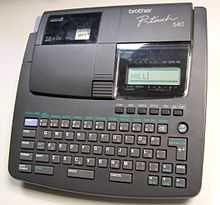Label printer
A label printer is a computer printer that prints on self-adhesive label material and/or card-stock (tags). A label printer with built-in keyboard and display for stand-alone use (not connected to a separate computer) is often called a label maker. Label printers are different from ordinary printers because they need to have special feed mechanisms to handle rolled stock, or tear sheet (fanfold) stock. Common connectivity for label printers include RS-232 serial, Universal Serial Bus (USB), parallel, Ethernet and various kinds of wireless.
Label printers have a wide variety of applications, including supply chain management, retail price marking, packaging labels, blood and laboratory specimen marking, and fixed assets management.
Mechanisms

Label printers use a wide range of label materials, including paper and synthetic polymer ("plastic") materials. Several types of print mechanisms are also used, including laser and impact, but thermal printer mechanisms are probably the most common. Two types of thermal printer are seen:
- Direct Thermal - Uses heat sensitive paper (similar to thermal fax paper). Direct thermal labels tend to fade over time (typically 6 to 12 months); if exposed to heat, direct sunlight or chemical vapors, the life is shortened. Therefore, direct thermal labels are primarily used for short duration applications, such as shipping labels.
- Thermal Transfer - Uses heat to transfer ink from ribbon onto the label for a permanent print. Some thermal transfer printers are also capable of direct thermal printing. Using a PVC vinyl can increase the longevity of the label life as seen in pipe markers and industrial safety labels found in much of the market place today.
There are three grades of ribbon for use with a thermal transfer printers:
- Wax is the most popular with some smudge resistance, and is suitable for matte and semi-gloss paper labels.
- Wax / Resin is smudge resistant, suitable for semi-gloss paper and some synthetic labels.
- Resin is scratch and chemical resistant, suitable for coated synthetic labels.
When printing on continuous label stock, there is a tendency for the print location to shift slightly from label to label. To ensure registration of the print area with the target media, many label printers use a sensor that detects a gap, notch, line or perforation between labels. This allows the printer to adjust the intake of label stock so that the print aligns correctly with the media.
Types of label printers
- Desktop label printers are usually designed for light- to medium-duty use with a roll of stock up to 4" wide. They are quiet and inexpensive.
- Commercial label printers can typically hold a larger roll of stock (up to 8" wide) and are geared for medium-volume printing.
- Industrial label printers are designed for heavy-duty, continuous operation in warehouses, distribution centers and factories.
- Industrial portable label printers are designed for heavy-duty operation on location. They are usually handheld and come with an industrial hard case. Examples of applications are labeling for electrical installations, construction sites, and production floors where there are no computers.
- RFID readers are specialized label printers that print and encode at the same time on RFID transponders (tags) enclosed in paper or printable synthetic materials. RFID tags need to have printed information for backwards compatibility with barcode systems, so humans can identify the tag.
- Label printer applicators are designed to automate the labeling process. These systems are common in manufacturing and warehousing facilities that require cases and pallets to be labeled for shipping.
- Label software is computer software which runs on a general-purpose personal computer, and is designed to create and/or format labels for printing. The software can use native OS printer drivers, or embed drivers in the software, bypassing the OS print subsystem. It may work with dedicated label printers as described in this article, or use sheet- or continuous-fed labels in a general-purpose computer printer.

- Personal label printers or label makers are handheld or small desktop devices. They are intended for home office, small office, or small business use. The cost of the printers is generally very low, making them popular with low volume users; but they print on special tapes, often thermal, which are usually expensive. In the past, mechanical systems which worked by embossing a colored plastic tape, called embossing tape, were common. A hammer in the shape of the letter caused a letter-shaped extrusion on the opposite side of the tape. The raised plastic would discolor, providing visual contrast. Today, this type has been almost completely displaced by electronic thermal transfer devices with built-in keyboard and display, and an integrated cartridge containing the label material (and print ribbon, if used).
See also
- Computer printer
- Barcode printer
- Barcode
- Embossing tape
External links
| Wikimedia Commons has media related to Label makers. |